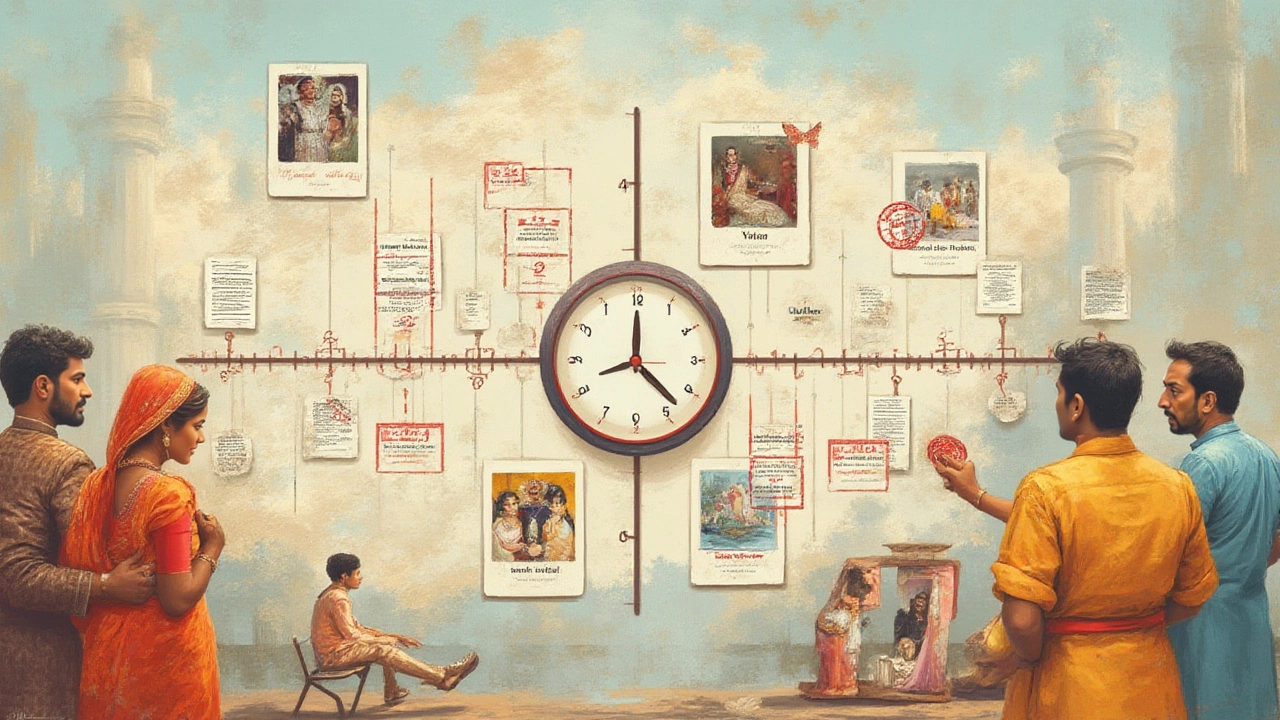Picture this: The decision’s made, hearts are heavy, and you’re ready to walk a new path—one without your spouse. But in India, divorce isn’t as quick as breaking up over coffee. You deal with laws, paperwork, reluctant family elders, and endless court dates. While billboards may scream “Divorce in 6 months!”, most people find themselves tangled in a time-consuming process. Some spend years trying to just get that one last signature. Want to know how long a divorce actually takes in India? There’s no single answer, but I’ll break it down for you. Expect sound advice, practical tips, and no sugar-coating. Real answers, for real people.
The Two Paths: Mutual Consent vs. Contested Divorce
When it comes to divorce under Indian law, you’ve got two main routes—mutual consent and contested divorce. Each has its own journey, speed bumps, and drama levels. Let’s dig into what both actually mean for you, because if you’re in this spot, the differences are about to change your life.
Mutual Consent Divorce is when both you and your spouse agree that the marriage has run its course. Think of it like two adults sitting down, admitting things just don’t work, and moving on. Makes things easier, but the law in India has a few rituals even here:
- You both need to live separately for at least one year before you even file the petition.
- Once you agree, you file the first motion in court and record your statements.
- There is a ‘cooling off’ period of six months after filing the first motion—basically time to see if you guys are really, really sure.
- After this, you return to court for the second motion. If both sides still agree, the judge grants the divorce.
Contested Divorce is a whole other beast. This kicks in when only one person wants out, or the couple can’t agree on alimony, child custody, or reasons for breaking up. This is the route where your patience really gets tested:
- The spouse wanting a divorce files a petition with specific grounds (cruelty, desertion, adultery, etc.).
- The other spouse gets a chance to respond and contest it.
- Arguments, counter-arguments, evidence, maybe a little family melodrama, and lots of legalese get thrown around.
- Court hearings are set for witness statements and cross-examinations.
- This is often where the process stretches for years. Sometimes you might walk into your first hearing and realize there’s another couple in front of you—still fighting the same case for the past five years.
Timelines You Should Expect: The Truth, Not Marketing
So, how long does divorce take in India? Here’s a snapshot of what actual people have faced, based on recent court statistics and good old-fashioned real-life stories.
| Type of Divorce | Minimum Duration | Average Duration | Maximum Duration Seen |
|---|---|---|---|
| Mutual Consent | 6 months | 8-14 months | 2 years |
| Contested | 1 year | 3-5 years | 20+ years |
If these numbers seem scary, you’re not wrong. It’s not just the official timeline. There are lots of hiccups along the way. For example:
- If paperwork is incomplete, the court will push your date forward.
- If your lawyer is double-booked or ill, your case gets delayed.
- If you or your spouse keep skipping hearings, the judge has little patience—your case may even get dismissed or pushed back even further.
- Disputes about property, money, or custody can drag even a mutual consent divorce into contested territory.
And yes, there are some wild stories out there. Like the Mumbai couple who spent 17 years in court just arguing about who should keep the dog. Or Delhiites stalled over a single photograph nobody wanted to give up. While these are extremes, you see how things can spiral without warning.
Some local courts in cities like Bengaluru or Pune, which handle a heavy volume of cases, try to move things quicker with ‘fast-track’ family courts. But even fast-track isn’t instant—think months, not weeks. The only time divorces really move fast is when both parties are totally in sync and courts are not overloaded—which is rare in most bigger cities.

The Main Steps in the Indian Divorce Process
No matter which route you take, the process is more than just signing a paper and moving on. Let’s walk through both. For mutual consent divorce:
- Both spouses file a joint petition in the family court.
- The first hearing: you both (and your lawyers) appear, submit ID proof, address proof, and marriage certificate.
- The court records your statements, checks for consent, and schedules the six-month cooling-off period.
- During this time, you can continue to live apart or negotiate terms (like alimony, custody) further, if needed.
- After six months, you return and file the second motion saying you’re still on the same page.
- The court listens, checks paperwork again, and passes the final decree if satisfied.
For contested divorce:
- One spouse files a divorce petition, stating grounds like cruelty, desertion, or adultery.
- The court issues summons to the other spouse and allows them to file a written response—this takes weeks, sometimes months, depending on how fast documents get served.
- Counter-allegations can fly back and forth for months.
- Court hearings are set for evidence and witness examination.
- Lawyers may call in character witnesses, collect documents, and cross-examine (think movies, but slower and more paperwork).
- The judge may call for mediation or counseling sessions—sometimes these help with reconciliation, other times just burn weeks off the calendar.
- Once evidence is submitted and arguments complete, the judge writes up the decision (decree).
- If someone appeals the decree, the case can go to High Court, which takes another year or more.
Every step comes with its own set of technicalities. If your spouse can’t be found to receive summons, the court can order a notice in the newspaper, which causes further delay. Some spouses purposely avoid showing up just to delay the process. There are cases where people switched jobs and cities just to avoid hearings—the game of hide and seek frustrates both you and the judge. And this is just the nuts and bolts. Throw in property disputes, child custody battles, dowry claims, and it becomes legal quicksand.
Tips, Shortcuts, and Realistic Expectations
Here’s the deal—no magic wand will give you a divorce in three weeks. But you can avoid some delays and headaches if you know what to do. Let’s talk shortcuts, tips, and things nobody tells you until you’re the one sitting outside the courtroom.
- Get paperwork straight: Missing documents are the number one reason for delayed cases. Keep copies of your marriage certificate, address proof, photos, and any agreements handy. This is your toolkit—without it, don’t even step into a lawyer’s office.
- Be present: Skipping court dates is your ticket to endless adjournments. Even if your lawyer says “it’s fine, I’ll handle today”, your physical presence makes things move faster and looks better in front of the judge.
- Avoid the blame game: For contested divorces, pushing tons of allegations just to win isn’t smart. Indian courts favor compromise or settlement, and wild accusations take time to prove—making your divorce longer, not easier.
- Mediation isn’t always bad: Sometimes, courts send you to a counselor or mediator. It’s not just about saving your marriage, it’s a chance to hammer out money or custody deals quickly, on neutral ground.
- Talk to your kids as early as possible: If you have children, sorting out custody early avoids last-minute drama in court. Judges want to see both sides are being responsible parents.
- Choose your lawyer wisely: Not all lawyers are in a rush to help you finish. A good one will push for fewer adjournments and handle paperwork right. If yours is dragging their feet, don’t be afraid to change.
- Keep backups of everything: Court files do get lost (seriously). Your own folders, scanned and emailed to yourself, can save weeks of extra hassle.
- If possible, opt for mutual consent: Even if you hate each other’s guts, nothing wastes time like years on a contested divorce. Cutting a deal, even if it means a little compromise, is the fastest way out.
- Know the holidays: Indian courts close for summer, Diwali, Christmas, and endless public holidays. Plan your dates so you aren’t stuck waiting for the courts to reopen.
Remember, there’s no right or wrong reason to want a divorce, but in India, the law is geared towards reconciliation, not quick breakups. The idea is to give couples time to rethink, talk and possibly make peace, which slows things—but sometimes that extra pause actually saves you from regrets. So if you’re racing towards freedom, set your expectations realistically.
You’ll hear rumors of “divorce agents” promising a decree in a month—in 2023, police busted networks in Lucknow and Hyderabad charging desperate couples lakhs of rupees for fake orders. Don’t fall for this. Only courts can grant a legal divorce, and shortcuts here will just leave you with paper that’s worth nothing.
If your spouse is abroad or NRI, courts have relaxed the rule in recent years. Video conferencing for statements is now allowed in many family courts, cutting down the need for expensive travel and helping move things a tad faster. Still, you’re looking at months, not weeks.
A 2022 National Judicial Data Grid report showed that, at the end of the year, nearly 900,000 matrimonial disputes were still pending in Indian courts. Family courts in metro cities like Delhi, Mumbai, and Bangalore are handling hundreds of fresh cases every day. So, patience isn’t just a virtue here—it’s the reality.


